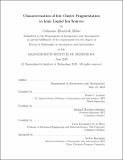Characterization of ion Cluster fragmentation in ionic liquid ion sources
Author(s)
Miller, Catherine Elizabeth.
Download1119667865-MIT.pdf (8.885Mb)
Other Contributors
Massachusetts Institute of Technology. Department of Aeronautics and Astronautics.
Advisor
Paulo C. Lozano.
Terms of use
Metadata
Show full item recordAbstract
Ion electrospray propulsion is a cutting-edge micropropulsion technology that could revolutionize the capabilities of microsatellites. Ion electrospray thrusters could also be used on large spacecraft for precision attitude control applications such as gravity wave detection and exoplanet imaging. Novel room temperature molten salts, called ionic liquids, are used as propellant, which are composed purely of positive and negative molecular ions. When exposed to strong electric fields, ions and metastable clusters of ions are evaporated from the bulk liquid surface. The free ions and ion clusters can be accelerated to high velocities, producing thrust at high specific impulse. The performance of ion electrospray thrusters is affected by the composition of the ion beam and the amount of ion clusters that break apart during the acceleration phase. To improve thruster performance, a better understanding of the fundamental physics of ion evaporation and cluster break-up is needed. The break-up of ion clusters, also called fragmentation, is not a well understood phenomenon. It has been observed in past experiments, but the rates of break-up have not been measured. The focus of this work is to experimentally investigate fragmentation more deeply than ever before. To accomplish this, a specialized instrumentation suite has been designed, built, and tested to measure fragmentation characteristics in unprecedented detail. A full-beam, spherical geometry retarding potential analyzer is used to measure the rates of fragmentation of ion clusters both outside the thruster and within the acceleration region for the first time. A narrow-beam, high time-resolution time of flight mass spectrometer is used to measure the beam composition. Single emitters based on resorcinol formaldehyde carbon xerogels were used as ion sources. Four ionic liquids spanning a wide range of liquid properties were characterized: EMI-FAP, EMI-Im, EMI-BF4, and BMI-I. Analytical models were also developed to enhance the interpretation of the experimental results. The experimental measurements show that the amount of fragmentation increases with distance from the thruster and follows a constant rate equation. The mean lifetimes of ion clusters outside of the thruster range from 1-6 [mu]s, indicating that these clusters are quite unstable. It is observed that the fragmentation throughout most of the acceleration region is linear with respect to electric potential, which can be understood using analytical models. Rapid fragmentation likely occurs immediately after evaporation due to the strong electric fields near the emission site, which has significant implications for thruster performance. It is also observed that clusters of complex molecular ions which consist of many atoms tend to be the most stable. The initial temperature of ion clusters, which range from 520 K - 790 K, were estimated using analytical methods. The effect of liquid temperature on the rates of fragmentation was also investigated. In conclusion, the work in this thesis provides a greatly enhanced understanding of ion cluster fragmentation, particularly how it is affected by ionic liquid properties, liquid temperature, and electric fields.
Description
This electronic version was submitted by the student author. The certified thesis is available in the Institute Archives and Special Collections. Thesis: Ph. D., Massachusetts Institute of Technology, Department of Aeronautics and Astronautics, 2019 Cataloged from student-submitted PDF version of thesis. Includes bibliographical references (pages 273-281).
Date issued
2019Department
Massachusetts Institute of Technology. Department of Aeronautics and AstronauticsPublisher
Massachusetts Institute of Technology
Keywords
Aeronautics and Astronautics.